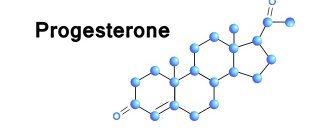Almost all biochemical processes occurring in the human body are controlled by hormones.
In a woman, estrogens and progestins “soleate”. The former are responsible for femininity, the latter for the possibility of conception and pregnancy.
The hormone progesterone is a biologically active substance that regulates the menstrual cycle and embryonic development.
What is the hormone progesterone
Progesterone is a hormone that controls reproductive function, the m/c (menstrual cycle) and the course of pregnancy. The slightest disruption of processes entails changes in hormone levels. It is the main progestogen in the body. It plays the role of a key metabolic intermediate in the synthesis of other endogenous steroids.
Despite the fundamental role of the hormone in the body, its properties and degree of influence on the body have not been fully studied. Only the prerequisites and some reasons are known that influence the jumps in indicators in relation to the normal limits.
Progesterone plays a major role in brain function as a neurosteroid.
Progesterone is produced by two organs:
- adrenal glands;
- a temporary secretory gland formed at the end of the ovulation period (the gland is also called the corpus luteum).
Thanks to the synthesis of the hormone in the female body, there is an active development of the mucous layer (lining of the uterus), stimulation of the process of formation of new blood vessels. Against the background of such changes, the preparation of the uterus to receive a fertilized egg begins. When pregnancy occurs, progesterone begins to be produced, including by the placenta.
The hormone level is influenced by the woman’s age and the m/c phase.
Normal menstrual cycle
As a rule, in the body of women, the amount of progesterone can change depending on nutrition, hormonal drugs (contraceptives), the presence of bad or healthy habits, sexual activity, physical activity, daily routine, pregnancy or menopause, and stress.
The menstrual cycle usually consists of four main phases:
- Menstrual phase. Its duration ranges from five to seven days. These are the days of menstruation, when the endometrium is shed, and the body prepares for the release of the next egg. This phase is characterized by the presence of menstrual flow.
- Follicular phase . In this phase, a new egg matures. Progesterone levels are normally in low concentrations. The normal duration of this phase can be 7-22 days in a healthy woman, depending on the individual characteristics of the reproductive system of a particular woman.
- Ovulatory phase. During this phase, a mature egg, ready for fertilization, leaves the ovary and moves into the fallopian tubes. The duration of the ovulatory phase is only three days. This time is very favorable for conception. A mature egg emerges from the ruptured follicle and moves toward the sperm for fertilization to occur. And if the egg does not meet the sperm, pregnancy does not occur, then the egg dies. If the egg is fertilized, conception occurs, then the already fertilized egg begins to quickly divide and moves through the tubes towards the uterus to burrow into the fluffy endometrium, thereby marking the beginning of a new life. And at the same time, the level of progesterone in the body is rapidly growing.
- Luteal phase. During this period of the cycle, the corpus luteum produces the hormone progesterone in the greatest quantities, directing all the body’s forces to maintain and develop a possible pregnancy. The length of this phase of the cycle is 13-14 days. If pregnancy does not occur in the current cycle, the corpus luteum dies, the level of hormones in the body drops sharply, and after one or two days the next menstruation occurs. It is due to the drop in hormone levels that unpleasant sensations and poor health arise on the eve of the next menstruation.
What functions does it perform?
Progesterone plays one of the fundamental roles in the female body.
Reproductive system
Another name for progesterone is the pregnancy hormone. Thanks to its effect, the process of preparing the uterus for conception begins. After fertilization, it reduces the immune response, which prevents embryo rejection. During pregnancy, progesterone helps ease pregnancy. After delivery, a decrease in its synthesis is a signal for the onset of lactation.
Hormonal balance
Progesterone is a participant in the synthesis of other hormones. An imbalance of the substance has a negative effect on the production of corticosteroids, aldosterone activity, and the functioning of estrogen.
Leather
The role of the hormone in subcutaneous processes is the subject of debate among scientists. There is a hypothesis that the presence of progesterone receptors in the epidermis forms a connection between the skin and the hormone. A decrease in hormone production can provoke the formation of wrinkles and loss of elasticity. The functionality of progesterone in this direction has been partially proven. The positive dynamics of hormone therapy are evidenced by numerous cases in which a significant improvement in the structure of the skin and its rejuvenation were recorded.
central nervous system
The production of progesterone is a prerequisite for the synthesis of allopregnanolone. Both hormones are involved in adaptation to stressful situations, are distinguished by immunomodulatory activity, and have cytoprotective properties. They are associated with molecular mechanisms of interruption of neurogenesis and neuroinflammation in the brain.
Sexual behavior
The tandem of progesterone and allopregnanolone stimulates libido in women. Research conducted on this topic has proven the connection between hormonal rise and sexual behavior of the fairer sex.
How progesterone changes a woman's health: 10 factors
There are days in a woman's life when the world seems to go crazy. Every little thing irritates you - the background noise of the TV on, a sharp phone call, the bright light of the sun in the windows. I want coffee and under the blanket - to go into hibernation, hang up a “Do not disturb!” sign. Women know: this is how PMS manifests itself.
But not everyone is aware that premenstrual syndrome is associated with a sharp drop in progesterone, the hormone that will be discussed in the article.
Progesterone determines a woman's life. It affects the possibility of conceiving a child, regulates immunity, and changes mood. Hormone imbalance can be a serious problem. Let's tell you how progesterone affects women's health.
The norm of progesterone in the blood of women
Standard limits for progesterone are conditional indicators that do not reflect pathologies caused by deficiency or increased levels of the hormone in the blood. When conducting research on biomaterial in women, different tabular forms are used.
Standard indicators for m/c phases | |
| Period name | Normal range, nmol/l |
| Follicular | 0,32-2,25 |
| Ovulation | 0,49-9,41 |
| Luteal | 6,95-56,63 |
| Postmenopause | less than 0.64 |
The large variation in periodic data is due to the influence of many factors. Among the main ones:
- emotional state of a woman;
- Times of Day;
- physical exercise;
- Lifestyle.
During pregnancy, the indicator is much higher than the values given in the table, which once again confirms the relationship between the hormone and reproductive function.
Indicators indicating the absence of pregnancy
Doctors recommend taking the test on days 21–22 of the cycle, but to calculate the progression of hormone growth, it is better to repeat several testing procedures - from days 19 to 23, or on days 24 or 25. The level of progesterone drops sharply before the onset of menstruation, so the absence of pregnancy can be determined by reading the test result.
| Phase | Cycle day | Volume of hormone in blood ng/ml | The volume of the hormone in the blood nmol/l |
| Menstruation | 1 to 6–7 | 0,2–0,9 | 0,34–2,31 |
| Follicular | 7–8 0,11–1,7 | 0,41–4,39 0,39–4,79 | |
| Ovulation | 13–15 | 0,13–2,8 | 0,46–9,39 |
| Luteal | 15–19 20–30 | 0,13–2,9 2,4–18,1 | 0,51–9,72 7,1–56,89 |
| Postmenopause | No more than 0.6 | 0,5–2,2 |
As can be seen from the table, the maximum progesterone peak is reached during the luteal phase, which is why taking the test before or after days 19–23 of the cycle is not recommended - the result will be incorrect.
How to take a progesterone test
The study does not require special preparation. But some nuances still exist.
- It is not recommended to eat food 8 hours before going to the clinic.
- If the m/c exceeds 31 days, blood is drawn on the 28-29th day.
Before collecting the biomaterial, the medical staff clarifies the date of the last menstruation and inquires about the monthly period.
If there are no problems with menstruation, blood sampling is planned on the 21st day of a 28-day cycle (in the morning). This is the most favorable time at which progesterone levels approach their highest levels. Sometimes the study is carried out on the 22-23rd day of the cycle. But such data have some margin of error.
Repeated testing may be required in case of m/c violations. The date is chosen taking into account ovulation, which is determined using rapid tests. A simple method involving temperature measurement is also used. Blood sampling is carried out on the 6-7th day after the release of the egg from the ovary into the fallopian tube.
During pregnancy and menopause, the test can be scheduled for any day.
Before donating the biomaterial, the patient consults with a specialist. Important information regarding the use of pharmaceuticals, diseases of the female organs, thyroid gland, and skin is clarified. If necessary, the doctor writes a referral to a specialist:
- gynecologist;
- endocrinologist;
- a dermatologist (if you have skin problems).
Analyzes
A gynecologist can prescribe a referral for a laboratory blood test. During the procedure, venous blood is taken with a syringe.
To obtain an objective picture, it is important to properly prepare for the diagnostic procedure.
When to take it
Doctors advise non-pregnant women to donate blood to determine hormonal levels on the 22nd day from the start of the menstrual cycle; it is better to do this in the morning before 11.00 strictly on an empty stomach.
Pregnant women can get tested on any working day. It is recommended to eat your last meal no later than eight hours before blood sampling. If you do not have regular periods, you will have to take the test several times a month.
It is advisable to stop taking medications that affect hormonal levels two weeks before the scheduled date.
If this cannot be done for health reasons, the patient must provide the laboratory with a treatment protocol that clearly outlines the dosage of the medications used.
It is important to exclude any physical activity, drinking alcohol, or smoking the day before the described diagnostic procedure.
When might elevated levels occur?
It is considered normal to increase hormone levels during pregnancy. However, progesterone can significantly exceed normative levels in non-pregnant women of childbearing age. Among the probable reasons:
- adrenal hyperplasia;
- corpus luteum cyst;
- ovarian tumor;
- chronic uterine bleeding;
- taking oral contraceptives and other medications that contain progestins;
- hormonal disbalance.
Ornament app
Monitor your health levels with Ornament. Ornament is a smartphone application that plots the dynamics of biomarkers. If the graph is yellow - the indicator is NOT normal, it is time to consult a doctor.
Only laboratory analysis can detect an increase in hormone levels. However, there are certain symptoms that appear when progesterone levels increase.
- The formation of a large number of pimples on the skin.
- Regular and quite severe headaches.
- Abundant body hair.
- Unreasonable weight gain.
- Fatigue, accompanied by stress and depression.
- Problems with the menstrual cycle.
- Increased allergic reaction.
- Unreasonable fluctuations in blood pressure in both directions.
- Painful sensations in the mammary glands.
- Vaginal discharge with blood drops.
Progesterone levels above normal may indicate pathologies such as dysfunction of the adrenal cortex. This is the most common problem that leads to a failure in the production of many hormones. They can be synthesized in insufficient quantities or in excess.
An increased level of progesterone often provokes pregnancy pathologies. For example, hydatidiform mole. Hormone levels exceed the highest threshold during pregnancy. The essence of the problem is the fertilization of an egg by two sperm at the same time, or the receipt of defective maternal material. The disease requires serious treatment, which includes chemotherapy. This approach is due to the high risk of developing malignant tumors.
High progesterone levels cause the development of ovarian cancer. To exclude predisposing factors, the patient is referred to a gynecologist before undergoing tests.
FAQ
When I was 9 weeks pregnant, I started spotting and it stopped a day later. Everything is normal on the ultrasound. The gynecologist says that you need to get tested for progesterone, and if the results are low, you need to start using Utrozhestan in suppositories. Is this analysis really necessary?
Spotting and spotting during this period can be due to various reasons. If in fact there was a threat of interruption, especially with a normal ultrasound picture, then there is no need to take the test. Utrozhestan is prescribed in very limited cases, more often in cases of recurrent miscarriage. Half of women with a threat of miscarriage successfully carry their pregnancy to term, while medicinal progesterone does not play any role.
I'm 6 weeks pregnant. Yesterday and today I noticed a decrease in basal temperature. Could this indicate a threat of miscarriage (after all, progesterone levels have most likely decreased)? What measures need to be taken?
Measuring basal temperature in modern medicine has no diagnostic value, just like progesterone levels during pregnancy. The threat of interruption is manifested by clinical symptoms: bleeding and abdominal pain. If in doubt, an ultrasound should be done. Most miscarriages at such an early stage have nothing to do with hormonal status, but occur due to genetic damage in the embryo.
Causes and symptoms of low progesterone
Reduced hormone levels are a predisposing factor for infertility and spontaneous abortion in the first trimester. Its deficiency leads to diseases of the female organs.
The following manifestations should raise suspicion:
- heavy and painful menstruation;
- enlargement of the mammary glands, sensation of pain when touching them;
- frequent and unreasonable changes in mood;
- increasing headaches;
- unusual irritability;
- swelling of the legs, the appearance of a feeling of heaviness in them;
- causeless weight gain;
- coldness in the extremities;
- pale, dry skin;
- hair loss;
- increased sweating;
- constipation;
- skin rash;
- bad dream.
The main provocateurs of a decrease in the hormone value are:
- sexual infections;
- corpus luteum deficiency;
- underdevelopment of the placenta;
- unstable menstrual cycle;
- taking hormonal pharmaceuticals for a long period;
- uterine bleeding.
Normal indicators at different periods of life
Hormone indicators are in dynamic equilibrium; different values are presented for each age interval. The norm of progesterone in women of reproductive age is presented below:
- 1st phase of the cycle - up to 3.6 nmol/l;
- days of ovulation - 1.52-5.4 nmol/l;
- luteal phase - 3.01-88.8 nmol/l;
- postmenopause - up to 0.64 nmol/l.
The norm in the luteal phase serves as the starting point for determining its amount in pregnant women. The embryo produces hCG, which is necessary to maintain the functioning of the corpus luteum. Therefore, the concentration of gestagen remains at the same level and gradually increases.
By the 16th week of pregnancy, the placenta is formed, which takes on hormonal functions. The concentration of the hormone gradually increases even more.
Normal indicators for trimesters of gestation are as follows:
- first trimester – 468.5 nmol/l;
- second trimester - 71.0-303.2 nmol/l;
- third trimester - up to 771 nmol/l.
Progesterone levels will inevitably decrease during menopause. This is explained by frequent menstruation without ovulation, when the egg does not mature and the corpus luteum does not form. Menopause is the period of complete cessation of menstruation. The norm for menopause is defined as 0.64 nmol/l. Along with progesterone, the amount of estrogen decreases at this age, which leads to changes in blood vessels, excess weight, calcium loss and deterioration of the condition of the skin, hair and nails.
Women of menopausal age are prescribed hormone replacement treatment with estrogen and progesterone. This combination is necessary to eliminate the negative effect of estrogen on the endometrium: if monotherapy is used, the likelihood of developing endometrial hyperplasia or cancer increases many times over. Progesterone compensates for the proliferative effect of estrogens and improves the general state of hormonal levels.
Progesterone during pregnancy
The interpretation of the hormone analysis is carried out by a qualified specialist - an obstetrician-gynecologist. It takes into account not only values relative to the norm, but also takes into account the duration of pregnancy and the nature of its course.
Progesterone levels during pregnancy | ||
| Trimester period | Hormone level, ng/ml | Hormone level, nmol/l |
| First (weeks: 13-24) | 35,6–286,2 | 11,19–90 |
| Second (by weeks: 1-12) | 81,2–284,3 | 25,5–89,4 |
| Third (by weeks: 25-42) | 153,9–1343,55 | 48,4–422,5 |
The highest value is observed in the third trimester. This feature is dictated by the body’s natural defense against premature birth. The data reflects the readiness of the birth canal for delivery and the mammary glands for the reproduction of mother's milk.
What phase occurs on the 21st day of the cycle?
This is the same luteal period, but the condition of the woman’s body begins to deteriorate sharply, which is due to natural processes in the body and should not come as a surprise.
In the absence of fertilization of the egg, the high concentration of progesterone and estrogen stops. The female body is gradually preparing for the onset of the next period. Premenstrual syndrome, which has gained sad popularity, is rightfully considered the most negative period in the life of all women.
Drugs to increase progesterone levels
Utrozhestan® (Utrogectan)
The basis of the composition is micronized progesterone. One capsule contains 100 or 200 mg (depending on the dosage of the medicine). The shape of the capsule 100 mg is round, 200 mg is oval. The filling of the gelatin shell is an oily homogeneous suspension.
The main directions for using pharmaceuticals internally:
- infertility due to luteal insufficiency;
- threat of miscarriage;
- premenstrual syndrome;
- fibrocystic mastopathy;
- menstrual irregularities due to infertility or failure of the ovulation process;
- Hormone replacement therapy during the menopausal transition or postmenopause.
The intravaginal method of using the product is also practiced. It is recommended for the following problems:
- non-functioning or absent ovaries;
- threat of abortion;
- premature menopause;
- infertility (cause - luteal insufficiency).
Utrozhestan is used in preparation for in vitro fertilization to support the luteal phase.
The pharmacological product has a number of restrictions on its use. The doctor must take them into account when developing a treatment regimen. Among the contraindications:
- allergy to the components of the composition;
- problems with veins (thrombosis);
- intracranial hemorrhage;
- stroke, heart attack;
- vaginal bleeding of unknown etiology;
- oncology of the mammary glands, genital organs;
- incomplete abortion;
- genetic pathology of the liver (porphyria), other diseases of the organ;
- lactation period;
- age up to 18 years.
The treatment regimen is determined individually. The annotation offers the following options:
- if there is a threat of miscarriage, take a daily dose of 200 to 600 mg/day. (prescribed in the third trimester only after assessing clinical data);
- during the menopausal transition – daily dose – 200 mg, course duration – 12 days;
- after menopause - the daily dose is from 100 to 200 mg, the duration of treatment is determined individually;
- to maintain the luteal phase - the daily norm is 200-400 mg, administration begins from the 17th to 26th day of the month, a ten-day course is proposed.
The cost of the product is about 400 rubles (dosage 100 mg, 28 capsules).
Progesterone
The product is available in the form of an injection solution of different concentrations: 10 and 25 mg. The active compound is progesterone.
The main direction of application of the pharmaceutical product:
- metrorrhagia;
- recurrent miscarriage;
- uterine bleeding associated with genital dysfunction;
- amenorrhea.
The treatment regimen is determined individually, taking into account the characteristics of the body and clinical trial data. The maximum daily allowance is 0.025 g.
Please read the restrictions before using the product. The medicine should not be used in the presence of kidney or liver dysfunction. The manufacturer also identifies the following contraindications:
- breast carcinoma;
- hepatitis;
- vaginal bleeding of unknown origin;
- thromboembolic pathologies.
The cost of the product is 306 rubles (dosage 10 mg/ml, 10 ampoules).
Solaray, Female Hormone Blend SP-7C, 180 Vegetarian Capsules
The product is developed based on components of plant origin. The rich composition helps restore the body's synthesis of various hormones important for women's health. Among the active ingredients used in production:
- liquorice root;
- raspberry leaves;
- chamomile;
- fenugreek seeds;
- wild yam, etc.
The dietary supplement is recommended for use in cases of high FSH, cycle disorders, and premenopause. Capsules should be taken three times a day before meals or with food.
The manufacturer warns of limitations. They apply to periods of pregnancy and lactation. It is also not recommended to take dietary supplements if your blood pressure is elevated. You should not use the composition if you are allergic to the components of the composition.
Average price – 801 rub.
What phase is the fifth day of the cycle?
This is still the same follicular stage, but the woman’s well-being gradually returns to normal, along with it her mood improves, and irritability goes away.
From the seventh to the eleventh day, almost all women experience an excellent mood. This period is characterized by satisfaction, big plans for the future, and high performance.
So, let's figure it out, on days 22 and 23 of the cycle, what is the phase?
Progesterone content in products
If there is a lack of progesterone, experts advise including foods containing natural hormones in the diet. They are well absorbed by the body, but they should not replace drug therapy. There will be no sharp increase in the indicator from food.
To bring progesterone levels to normal limits, it is recommended to include in the menu dishes prepared from the following ingredients:
- avocado;
- olives, olives;
- nuts (raw);
- sunflower seeds, pumpkin seeds;
- corn;
- egg yolks;
- pork;
- seafood, river fish;
- rice, legumes, cabbage of different varieties and varieties.
The list of products is actually impressive. This allows you to diversify the menu and satisfy the taste requirements of even a gourmet.
With timely control of progesterone, serious health problems can be avoided. The manifestation of characteristic symptoms indicating a violation of hormone synthesis requires an urgent visit to the clinic for consultation and referral for analysis. Small deviations from the norm are corrected quickly, you just need to follow the recommendations of your doctor.











